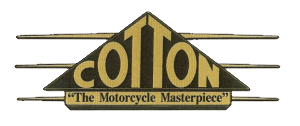

Cotton have been producing Motorcycles since 1919.
TT racing success in the twenties made a reputation for the company, and in its first eleven years the company turned out over 6,000 motorcycles.
1960 Scrambles models were introduced, using the 246cc Villiers 33A engine, as well as a sports version of the Herald, the Double Gloucester.
1961 The range expanded with modified engines and new frames. These were the 9E Vulcan Sports, a 246cc Trials wth a 32A engine, a second Scrambler wth a 34A, the road Corsair wih a 31A engine, and the Continental 29cc twin with a new frame and a sporting style.
1962 The range was joined by the Cougar scrambler, with a new frame and a modified 34A engine.
1963 Two new models appeared using the 247cc Villiers Starmaker engine. One was the Cobra, a scrambler, and the other the Telstar, built for road racing.
1964 Fewer models were produced as the emphasis was more on sports and competition, and this set the trend for the next few years. The Continental Sports twin, Starmaker Trials and Cobra Sprecial models were introduced in an attempt to win customers in a declining market. Despite this effort, each year saw fewer models, until there were only three left.
1968 Decline continued and Villiers ceased proprietary engine production, which affected many British firms.
Early 1970s. Kit-form trials bikes were then produced, using the 170cc Minarelli engine.
1974 The kit was then listed as the Cavalier
1975 Late in the year it was replaced by the Meteor scrambler with a 125cc Minarelli engine.
1976 The Meteor went, but they were able to use a Villiers-type engine made by DMW for a trials model. They later became involved with both CCM and Armstrong.
1979 The Cotton-ECM road racer emerged with a 250cc tandem-twin two-stroke Rotax engine in a mono-shock frame with Marzocchi forks, Brembo brakes and Dymag wheels. With it came motocross models in 125cc, 250cc and 400cc sizes, but these quickly became Armstong models, and thus brought the Cotton name to an end.
1991 Fluff Brown revived the Cotton name and since then replicas of the 1960s bikes have been built by AJS Motorcycles of Hampshire. This company was formed when FB-AJS took on the AJS line in 1974, and the nostalgia boom of the 1990s saw continued demand for these machines.
If you have further information or a query related to this page, please contact us